#Helene Weigel
Text
6 maggio … ricordiamo …
6 maggio … ricordiamo …
#semprevivineiricordi #nomidaricordare #personaggiimportanti #perfettamentechic
2022: Eugenio Allegri, attore e regista italiano.(n. 1956)
2021: Paul Van Doren, è stato un imprenditore statunitense, fondatore della Vans, azienda di scarpe negli Stati Uniti. Van Doren ha avuto cinque figli: Paul Jr., Steve, Cheryl, Taffy e Janie. Il suo libro di memorie, Authentic , è stato pubblicato nove giorni prima della sua morte. (n. 1930)
2020: Martin Spellman, attore statunitense,…

View On WordPress
#6 maggio#Ann Todd#Arnaldo Ninchi#Charles Farrell#Eugenio Allegri#George Lindsey#Guido Brignone#Guy Williams#Helene Weigel#Luigi Almirante#Maria Laura Rocca#Marlene Dietrich#Martin Spellman#Morti 6 maggio#Oswald Birley#Paolo Ferrari#Paul Van Doren#Personaggi morti 6 maggio#Ricordiamo#Sir Oswald Hornby Joseph Birley#Virginia Belmont#Vittorio Zarfati
0 notes
Text
Furcht und Elend im dritten Reich (~ 'Fear and Misery in the Third Reich' original title: Deutschland - Ein Greuelmärchen, based on H. Heine's "Deutschland ein Wintermärchen"; the final title is a reference to Balzac's novel "Glanz und Elend der Kurtisanen") by Bertolt Brecht and Helene Weigel -
written between 1935 and 1939 in emigration.
Based on eyewitness reports and newspaper notes.
The scenes were printed in 1938 for the Malik publishing house in Prague, but could no longer be distributed as a result of the Hitler invasion.

Excerpt from the play - notes, historical considerations and interpretations
'For the poor' and yet against them [excerpt from the 24 chapters, especially considering the propagandistic claim to be politics for the poor, whereas the ideas are more and more intensifying the precariousness, free translation of mine]
"There they come down:
A pale, motley
heap. And high in front
A cross on blood-red flags
That has a big swastika
For the poor man"
[The German Army Show, 2nd verse]
"The widows and orphans are coming
For them a good time
is promised too.
But first they must sacrifice and tax
Because they make meat more expensive.
The good time is far away."
[Chap. XI.]
"The class conciliators press
For boots and bad food
The poor to labour service.
They see a year in the same kit
The sons of the rich.
Would rather have a profit."
[Chap. XII.]
"The winter helpers enter
With banners and trumpets
Even into the poorest house.
They proudly drag extorted
Rags and leftovers
For the poor neighbour.
The hand that slayed their brother
Is enough for them not to complain
A charitable gift in a hurry.
The alms wafers remain
Stuck in their throats
And the Hitler salvation too."
[Chapter XVI.]
"They fetch the young and tan
dying-for-the-rich
Like the multiplication table.
Dying is probably harder.
But they see the teachers' fists
And are afraid to be fearful."
[Chap. XXI.]
"The job creators are coming.
The poor man is their kaffir
They put him where they want.
He may serve them again
He may pay their war machines
Pay blood and labour sweat."
[Chap. XXIII.]

VI The practicing of law; Augsburg 1934, consultation room in a courthouse; magistrate uncertain about the jurisdiction
Introductory poem
"Then the master judges
came
To whom the rabble said:
Law is what benefits the German folk.
They said: How are we supposed
to know that?
So they will have to speak in accordance
with the laws
Until the whole German people are seated."
Conversation between magistrate and inspector
The indictment consists of only one page and is the "leanest and sloppiest that the district judge has ever come across"
Inspector: Mr District Judge, I have a family
Consideration of charges by provocation
District judge and inspector
Problem: certifying the Jew's innocence means that in the Third Reich a Jew can be proven right against the SA; solution: the SA stole the jewellery in national excitement
Maid
"Half of the storm are former criminals, the whole neighbourhood knows that. If we didn't have our justice system, they would still be dragging away the cathedral church."
Magistrate and district court judge
"I'm prepared to do anything, Jesus, understand me! You've changed completely. I'll decide like this, and I'll decide as required, but I have to know what's required. If you don't know that, there is no justice."
Hist. Background: National Socialist propaganda effectively used the justice system to spread its ideology and influence the population. The National Socialist justice system was used by the National Socialist German Labour Party (NSDAP) as an instrument to enforce its ideology and propaganda.
Development of the Justice System:
Guidelines for National Socialist propaganda in Hitler's "Mein Kampf": Adolf Hitler already emphasised the importance of propaganda aimed at the feelings of the masses in his work "Mein Kampf"; Psychology of the masses
Before 1933: Propaganda techniques were used even before the Nazis came to power.
After 1933, however, the judicial system was heavily politicised and used for the National Socialist agenda
After the Nazis came to power in 1933: The Reich Ministry for Popular Enlightenment and Propaganda, under the leadership of Joseph Goebbels, played a central role in the dissemination of National Socialist propaganda. Books, newspapers, radio and films were used as means of dissemination.
Instrumentalisation of the judiciary:
The judical system was violeted for politcal purpose. The undermining and politicisation of the judiciary increased arbitrariness and lawlessness
The control of public communication had a high priority for the regime, for strenghening the power and to prepare the propaganda for the war and the extermination of Eurpean Jews.
Notices in German [formatting costed too much energy and nerves, just was able to correct a bit - very unordentlich!]
#literature#world literature#Bertolt Brecht#reading stage-play aloud#stage-play#reading#books about nationalsocialism#1935#1939#Brecht#Helene Weigel#remembering against fascism#fascism
1 note
·
View note
Text

Mt. St. Helens, 1975
361 notes
·
View notes
Text

Rudolf Schlichter - Portrait of Helene Weigel (1928)
83 notes
·
View notes
Text
I've found it! I wasn't expecting to, but I've found a recording of a Brecht play with Peter in it! You'll first hear him at the 12 minute mark
6 notes
·
View notes
Text
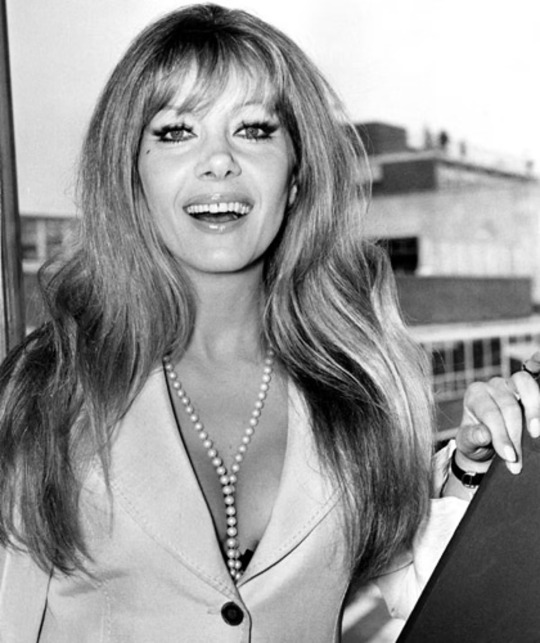
Celebrating Ingrid Pitt
Ingrid Pitt (born Ingoushka Petrov; 21 November 1937 – 23 November 2010) was a Polish-British actress and writer best known for her work in horror films of the 1970s.
Ingoushka Petrov was born in Warsaw, Poland, one of two daughters of a father of German Jewish descent and a Polish Jewish mother. During World War II, she and her mother were imprisoned in Stutthof concentration camp in Sztutowo, Free City of Danzig (present-day Nowy Dwór Gdański County, Pomeranian Voivodeship, Poland) but escaped. In Berlin, in the 1950s, Ingoushka married an American soldier, Laud Roland Pitt Jr., and moved to California. After her marriage failed she returned to Europe, but after a small role in a film, she took the shortened stage name "Ingrid Pitt", keeping her former husband's surname, and headed to Hollywood, where she worked as a waitress while trying to make a career in films.
In the early 1960s, Pitt was a member of the prestigious Berliner Ensemble, under the guidance of Bertolt Brecht's widow Helene Weigel. In 1965, she made her film debut in Doctor Zhivago, playing a minor role. In 1968, she co-starred in the low-budget science-fiction film The Omegans, and in the same year, played British spy Heidi Schmidt in Where Eagles Dare opposite Richard Burton and Clint Eastwood.

Her work with Hammer Film Productions elevated her to cult figure status. She starred as Carmilla/Mircalla in The Vampire Lovers (1970), based on Joseph Sheridan Le Fanu's novella Carmilla, and played the title role in Countess Dracula (1971), based on the legends about Countess Elizabeth Báthory. Pitt also appeared in the Amicus horror anthology film The House That Dripped Blood (1971) and had a small part in The Wicker Man (1973).

During the 1980s, Pitt returned to mainstream films and television. Her role as Fraulein Baum in the 1981 BBC Playhouse Unity, who is denounced as a Jew by Unity Mitford (Lesley-Anne Down), was uncomfortably close to her real-life experiences. Her popularity with horror film buffs had her in demand for guest appearances at horror conventions and film festivals. Other films in which Pitt has appeared outside the horror genre are: Who Dares Wins (1982) (or The Final Option), Wild Geese II (1985) and Hanna's War (1988). Generally cast as a villainess, her characters often died horribly at the end of the final reel. "Being the anti-hero is great – they are always roles you can get your teeth into."

In the 1980s she also reinvented herself as a writer. Her first book, after a number of ill-fated tracts on the plight of Native Americans, was the 1980 novel, Cuckoo Run, a spy story about mistaken identity. "I took it to Cubby Broccoli. It was about a woman called Nina Dalton who is pursued across South America in the mistaken belief that she is a spy. Cubby said it was a female Bond. He was being very kind."
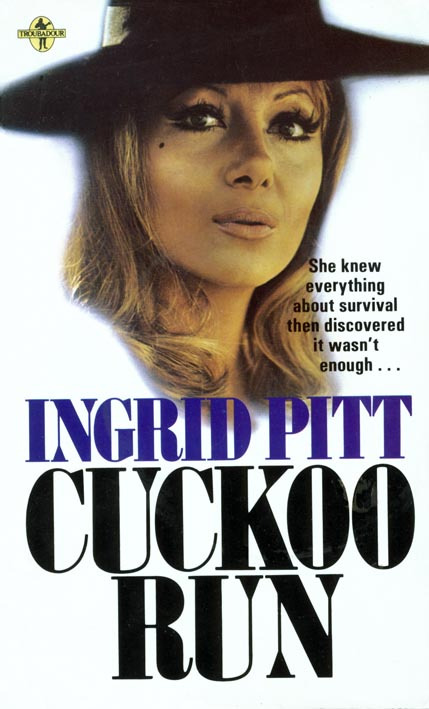
In 1999, her autobiography, Life's a Scream (Heinemann) was published, and she was short-listed for the for her own reading of extracts from the audio book.
The autobiography detailed the harrowing experiences of her early life—in a Nazi concentration camp, her search through Europe in Red Cross refugee camps for her father, and her escape from East Berlin, one step ahead of the Volkspolizei. "I always had a big mouth and used to go on about the political schooling interrupting my quest for thespian glory. I used to think like that. Not good in a police state."

Pitt died in a south London hospital on 23 November 2010, a few days after collapsing, and two days after her 73rd birthday, from congestive heart failure.

Seven months before she died, Pitt finished narration for Ingrid Pitt: Beyond the Forest (2011), an animated short film on her experience in the Holocaust, a project that had been in the works for five years. Character design and storyboards were created by two-time Academy Award-nominated filmmaker Bill Plympton. The film is directed by Kevin Sean Michaels; co-produced and co-written by Jud Newborn, Holocaust expert and author, "Sophie Scholl and the White Rose"; and drawn by 10-year-old animator, Perry Chen.
vimeo
#Ingrid Pitt#The Vampire Lovers#Countess Dracula#Academy Award#Anne Frank#Holocaust#Nazi#Where Eagles Dare#Kevin Sean Michaels#Hammer Films#The Wicker Man#The House That Dripped Blood#concentration camp#Stutthof concentration camp
127 notes
·
View notes
Text
Nero's display picture is the actor Jackie Gleason protraying a character called Ralph Kramden in a TV show called the Honeymooners. i think choosing an avatar is for most forum users a kind of personality fashioning; the reader is expected to interpret something about the picture's nature and infer a connection with something about the user. this is why tumblr's 'mature content' prison can feel so devastating; bound, shaved, marked and castrated, you scarcely recognize yourself in your own posts. when it happened to me a friend sent an ask saying that they missed "the lore that little anime girl on the corner adds to [my] essays" (click). so how do you interpret Nero with Nero's display picture? i see four options: (i) i interpret Nero in light of the actor Jackie Gleason—the finely dressed Old Hollywood actor who we remember from the Hustler and as the conductor of the orchestra on Music for Lovers Only, (ij) i interpret Nero in light of the character Ralph Kramden, the (according to the wiki, click) brash, impulsive, short-tempered bus driver from the Honeymooners (the Unofficial Honeymooners Site, click, which either plagiarizes or is plagiarized by Wikipedia, goes on to link, as a demonstration of his personality, a video compilation of Every Fat Joke From the Classic 39 Episodes, which you can watch if you so desire, click), (iij) i interpret Nero in light of the dramatic sequence which Gleason is performing, the narrative of the episode, the artistic purpose it achieves, whatever the character presently says in the scene and so forth, or (iiij) i interpret Nero without any reference to the actor, character or show implicated by the picture, but instead purely by the force of the gesture in its immediacy, in this case a man pretending to hang himself, his mouth open in grotesque asphyxiation, similar to the chilling silent scream of Mother Courage interpreted by Helene Weigel (click).

15 notes
·
View notes
Text

feeling alienated at the helene weigel swimming pool
2 notes
·
View notes
Text

Rudolf Schlichter - Porträt Helene Weigel. 1928
3 notes
·
View notes
Text
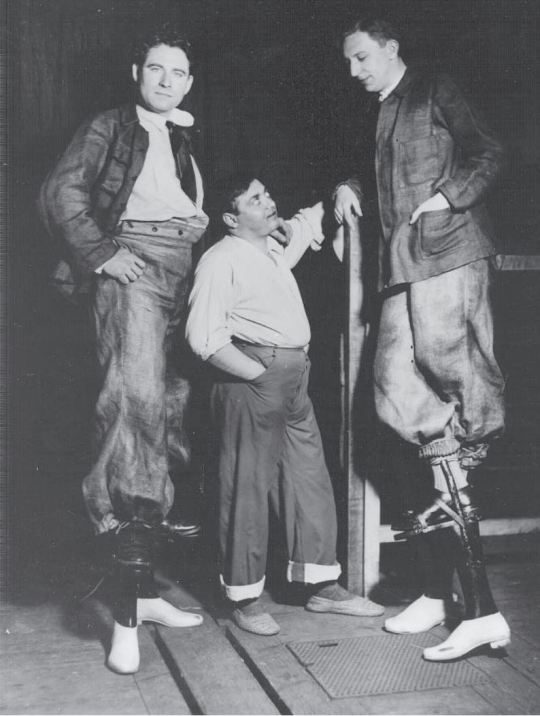
Peter Lorre behind the scenes of Mann ist Mann (Staatstheater, Berlin, 1931) with Alexander Granach (who played Jesse Mahoney) and Theo Lingen (who played Uria Shelley). Something about his hand in his pocket and his almost swagger-stance just sends me.
Here's Peter with Helene Weigel. Peter played Galy Gay, an Irish packer, who transforms into soldier Jeremiah Jip. Helene played Leokadja Begbick, a prostitute:
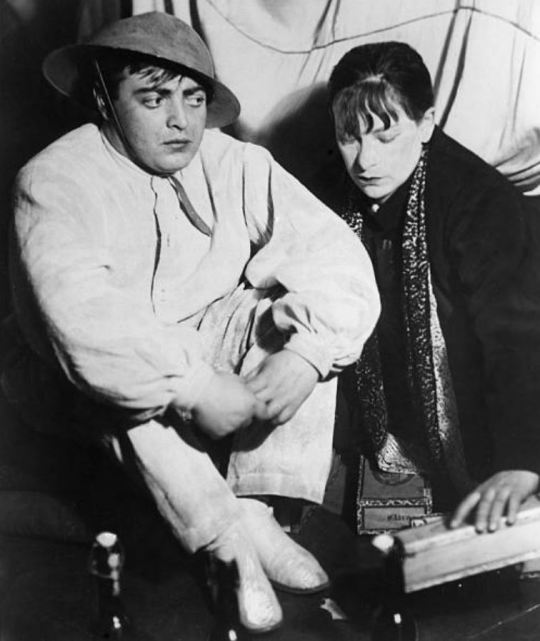
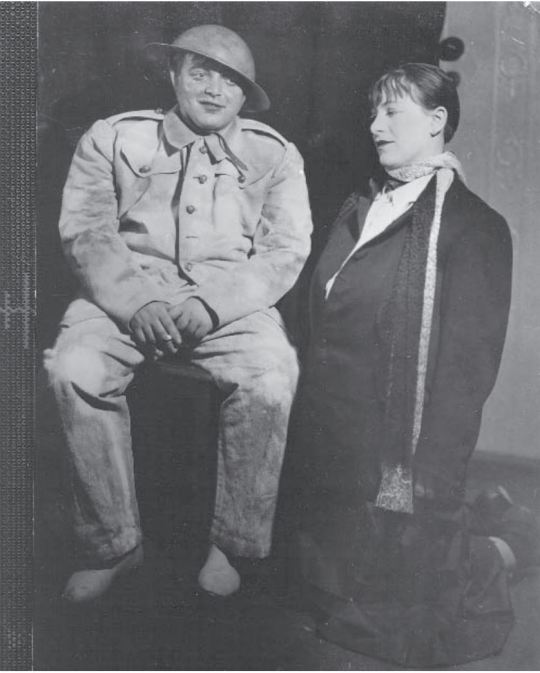
Peter as Galy Gay (before his transformation into Jeremiah Jip) taking a break with Elfriede Borodin, who played his wife:
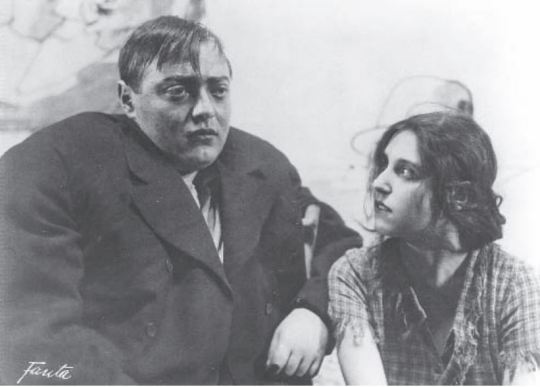
Can we just take a moment or more to admire his lips. Holy god those lips. Sensuous!
More about the play:
"During the five sub-scenes of the sequence, the three soldiers and the prostitute Begbick convince Galy Gay to sell a puppet elephant, persuading him that the animal is real because there is a buyer for it; subsequently, they take him into custody for stealing the elephant, put him on trial and stage his execution, so that the man convinces himself of his own death and starts thinking that he is Jeremiah Jip, the fourth, missing soldier of the squad. the sequence consists of short sub-scenes structured like clown numbers in which the farcical tone is produced by the act of mocking a character as naïve and intellectually passive as Galy Gay, repeatedly described as "someone who cannot say no." Source
Images from "The Lost One: A Life of Peter Lorre."
#peter lorre#Mann ist Mann#1930s german theatre#peter lorre theatre#peter lorre stage#galy gay#jeremiah jip#bertolt brecht#helene wiegel#peter lorre lips
15 notes
·
View notes
Text

Rudolf Schlichter, Helene Weigel, 1928, oil on canvas, Städtische Galerie im
Lenbachhaus and Kunstbau München, on loan from the Ernst von Siemens Kunststiftung
Lenbachhaus
12 notes
·
View notes
Text


HELENE WEIGEL CAMEO IN THE SEVENTH CROSS???????????
3 notes
·
View notes
Text
0 notes
Text

St. Helens through the Trees, 1983
79 notes
·
View notes
Text
Providing In-Depth Horoscope and Personality Analysis for May 12 Birthdays
They are individuals with a cordial, very serene and respectful disposition. Close to home, delicate: they show dependability in their connections. They can adjust to life circumstances. They can accomplish huge advantages through associations with others. Genuine companions will help you particularly. They can resolve their lives in an agreeable manner. They are truly keen on singing and music. Because of these interests, they even become craftsmen, painters, or scholars. They show extraordinary adroitness in manual work, which permits them to acquire amazing outcomes in the applied expressions. They can likewise be astounding specialists. Your endeavors and difficult work will ultimately be delegated with progress. They have a fundamental energy in overabundance, and they have it in sports, love or work. A side interest that can hurt them is gastronomic, in light of the fact that it could cause liver or kidney illnesses. Likewise, they frequently show a propensity to put on weight. People brought into the world at sunrise are better and stronger. Imperfections: The lacking sort rapidly ejects out of resentment. He is eccentric, constrained by his interests. Albeit languid, he is fit for playing around. Imperious, excessively basic.
Providing In-Depth Horoscope and Personality Analysis for May 12 Birthdays
Assuming your birthday is on May 12, your zodiac sign is Taurus
May 12 - character and character
character: immaculate, kind, determined, erratic, forceful, antagonistic; calling: humanist, nurture, writer; colors: purple, brown, white; stone: lapis lazuli; creature: snail; plant: nasturtium; fortunate numbers: 10,15,23,26,39,54 very fortunate number: 3
Occasions and observances - May 12
Worldwide Fibromyalgia Day.
Worldwide Nursing Day.
Worldwide Day of the Section of Beginning wine development.
May 12 VIP Birthday. Who was conceived that very day as you?
1900: Pedro Puig Adam, Spanish mathematician (f. 1960). 1900: Helene Weigel, German entertainer (d. 1971). 1907: Katharine Hepburn, American entertainer (d. 2003). 1910: Dorothy Crowfoot Hodgkin, English scientific expert, 1964 Nobel Prize victor for science (d. 1994). 1910: Johan Ferrier, Surinamese president (d. 2010). 1910: Giulietta Simionato, Italian soprano (d. 2010). 1913: Jamelao, Brazilian samba player (f. 2008). 1914: Bertus Aafjes, Dutch author (d. 1993). 1918: Julius Rosenberg, American covert agent (d. 1953). 1918: Mary Kay Debris, organizer behind the beauty care products organization Mary Kay Beauty care products (d. 2001). 1920: Vilდ©m Flusser, Czech author (d. 1991). 1921: Joseph Beuys, German craftsman (d. 1986). 1922: Marco Denevi, Argentine author (f. 1998). 1924: Claribel Alegrდa, Nicaraguan author. 1925: Yogi Berra, American baseball player. 1926: Luis Molowny, Spanish footballer and mentor (d. 2010). 1928: Burt Bacharach, American arranger. 1929: Sam Nujoma, Namibian legislator. 1929: დ?gnes Heller, Hungarian logician. 1930: Jesდºs Franco, Spanish movie producer (d. 2013). 1930: Tirofijo (Manuel Marulanda Vდ©lez), Colombian guerrilla, commandant of the FARC (d. 2008). 1935: Felipe Alou, Dominican baseball player. 1936: Guillermo Endara Galimany, Panamanian legislator and attorney, president somewhere in the range of 1989 and 1994. 1936: Honest Stella, American painter. 1937: George Carlin, American comic (d. 2008). 1942: Michel Fugain, French vocalist. 1945: Alan Ball, English footballer. 1945: Claudia Sauce, Spanish entertainer brought into the world in Zaire. 1948: Guillermo Pდ©rez Villalta, Spanish painter. 1948: Richard Riehle, American entertainer. 1948: Steve Winwood, English performer, of the band Traffic. 1950: Gabriel Byrne, Irish entertainer. 1958: Eric Artist, American performer, of the groups Kiss and Alice Cooper. 1959: Ving Rhames, American entertainer. 1962: Emilio Estდ©vez, American entertainer. 1962: Brett Gurewitz, American guitarist. 1962: Einar Arnaldur Melax, Icelandic artist and writer, of the band The Elgar Sisters. 1963: Stefano Modena, Italian Equation 1 driver. 1963: Gavin Hood, South African producer. 1963: Beatriz Valdდ©s, Cuban-Venezuelan theater, film and TV entertainer. 1966: Stephen Baldwin, American entertainer. 1966: Bebel Gilberto, Brazilian artist. 1966: Deborah Kara Unger, Canadian entertainer. 1967: Paul D'Amour, American bassist, of the band Device. 1968: Tony Bird of prey, American skater. 1970: Samantha Mathis, American entertainer. 1971: Alejandro Irarragorri, Mexican money manager. 1972: Antonio Bosch Conde, Spanish author. 1972: Yadhira Carrillo, Mexican entertainer. 1975: Jonah Lomu, New Zealand rugby player. 1978: Sied van Riel, Dutch DJ and maker 1978: Jason Biggs, American entertainer. 1978: Malin Akerman, Swedish entertainer, model and vocalist. 1979: Joaquim Rodrდguez, Spanish cyclist. 1980: Keith Bogans, American b-ball player. 1980: Silvestre Dangond, Colombian vocalist lyricist of Vallenata music. 1980: Paula Woyzechowsky, Venezuelan entertainer and model. 1980: Alexandra de la Mora, Mexican entertainer. 1981: Rami Malek, American entertainer. 1981: Erica Campbell, American model. 1981: Andre Brown, American ball player. 1983: Alina Kabდ¡yeva, Russian athlete. 1983: Axel Hervelle, Belgian ball player. 1983: Domhnall Gleeson, Irish entertainer. 1984: Justin Williams, American ball player. 1985: Jaime Gavilდ¡n Martდnez, Spanish footballer. 1985: Paolo Goltz, Argentine footballer. 1986: Emily VanCamp, Canadian entertainer. 1986: Mouhamed Sene, Senegalese ball player. 1986: Victor Liz, Dominican ball player. 1988: Marcelo Vieira, Brazilian soccer player. 1991: Joe Dombrowski, American cyclist. 1992: Malcolm David Kelley, American entertainer. 1995: Luke Benward, American entertainer.
0 notes
Text
Speaking of Mr. Brecht, one of the things I made my friends do while we where in Berlin was visit his and Helen Weigel's graves. It's a beautiful cemetery they're in. If you're ever in Berlin I recommend visiting them.
1 note
·
View note